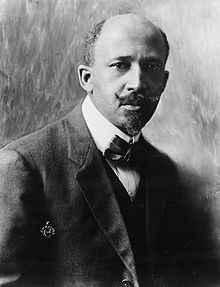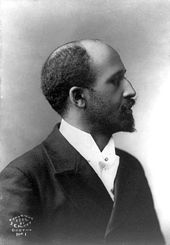Education and Empowerment
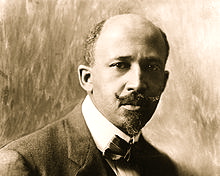
The Talented Tenth Memorial Address by W.E.B. Du Bois
Author of Education and Empowerment, Randall Westbrook, talks about W.E.B. Du Bois’ speech that marks the beginning of his downfall, which compares his expectations of the impact of his favorite work, “The Talented Tenth”, with the actual consequences.
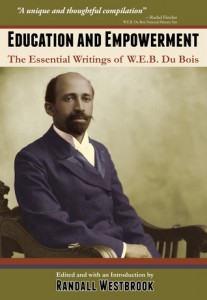 Education and Empowerment: The Essential Writings of W.E.B. Du Bois by Randall Westbrook
Education and Empowerment: The Essential Writings of W.E.B. Du Bois by Randall Westbrook
W.E.B. Du Bois scholar and university professor, Randall Westbrook, compiles twenty-four writings by W.E.B. Du Bois and analyzes them in the context of educational thought. Spanning eighty years, Westbrook begins with Du Bois’ first writings at age fifteen and continues to parallel Du Bois’ life and career as an academic, innovative thinker and writer, as well as public speaker in his efforts to inspire the Black community to”elevate their race” through literacy, education, and political awareness.
William Edward Burghardt “W. E. B.” Du Bois (pronounced /duːˈbɔɪz/doo-boyz; February 23, 1868 – August 27, 1963) was an American sociologist,historian, civil rights activist, Pan-Africanist, author and editor. Born in Great Barrington, Massachusetts, Du Bois grew up in a relatively tolerant and integrated community. After graduating from Harvard, where he was the first African American to earn a doctorate, he became a professor of history, sociology and economics at Atlanta University. Du Bois was one of the co-founders of the National Association for the Advancement of Colored People (NAACP) in 1909.
Du Bois rose to national prominence as the leader of the Niagara Movement, a group of African-American activists who wanted equal rights for blacks. Du Bois and his supporters opposed the Atlanta Compromise, an agreement crafted by Booker T. Washington which provided that Southern blacks would work and submit to white political rule, while Southern whites guaranteed that blacks would receive basic educational and economic opportunities. Instead, Du Bois insisted on full civil rights and increased political representation, which he believed would be brought about by the African-American intellectual elite. He referred to this group as the talented tenth and believed that African Americans needed the chances for advanced education to develop its leadership.
Racism was the main target of Du Bois’s polemics, and he strongly protested against lynching, Jim Crow laws, and discrimination in education and employment. His cause included colored persons everywhere, particularly Africans and Asians in their struggles against colonialism and imperialism. He was a proponent of Pan-Africanism and helped organize several Pan-African Congresses to free African colonies from European powers. Du Bois made several trips to Europe, Africa and Asia. After World War I, he surveyed the experiences of American black soldiers in France and documented widespread bigotry in the United States military.
Du Bois was a prolific author. His collection of essays, The Souls of Black Folk, was a seminal work in African-American literature; and his 1935 magnum opus Black Reconstruction in America challenged the prevailing orthodoxy that blacks were responsible for the failures of the Reconstruction era. He wrote the first scientific treatise in the field of sociology; and he published three autobiographies, each of which contains insightful essays on sociology, politics and history. In his role as editor of the NAACP’s journal The Crisis, he published many influential pieces. Du Bois believed that capitalism was a primary cause of racism, and he was generally sympathetic to socialist causes throughout his life. He was an ardent peace activist and advocated nuclear disarmament. The United States’ Civil Rights Act, embodying many of the reforms for which Du Bois had campaigned his entire life, was enacted a year after his death.
Early life
 As a child, Du Bois attended the Congregational Church in Great Barrington, Massachusetts. Church members collected donations to pay Du Bois’s college tuition.
As a child, Du Bois attended the Congregational Church in Great Barrington, Massachusetts. Church members collected donations to pay Du Bois’s college tuition.
William Edward Burghardt Du Bois was born on February 23, 1868, in Great Barrington, Massachusetts, to Alfred and Mary Silvina (née Burghardt) Du Bois. Mary Silvina Burghardt’s family was part of the very small free black population of Great Barrington, having long owned land in the state; she was descended from Dutch, African and English ancestors. William Du Bois’s maternal great-grandfather was Tom Burghardt, a slave (born in West Africa around 1730) who was held by the Dutch colonist Conraed Burghardt. Tom briefly served in the Continental Army during the American Revolutionary War, which may have been how he gained his freedom. Tom’s son Jack Burghardt was the father of Othello Burghardt, who was the father of Mary Silvina Burghardt.
William Du Bois’s paternal great-grandfather was an ethnic French-American, James Du Bois of Poughkeepsie, New York, who fathered several children with slave mistresses. One of James’ mixed-race sons was Alexander, who traveled to Haiti, and fathered a son, Alfred, with a mistress there. Alexander returned to Connecticut, leaving Alfred in Haiti with his mother. Alfred moved to the United States sometime before 1860, and married Mary Silvina Burghardt on February 5, 1867, in Housatonic, Massachusetts. Alfred left Mary in 1870, two years after William was born. William’s mother worked to support her family (receiving some assistance from her brother and neighbors), until she experienced a stroke in the early 1880s. She died in 1885.
Great Barrington’s primarily European American community treated Du Bois generally well. He attended the local integrated public school and played with white schoolmates, though the racism he experienced even in this context would be one of the subjects of his later adult writing. Teachers encouraged his intellectual pursuits, and his rewarding experience with academic studies led him to believe that he could use his knowledge to empower African Americans. When Du Bois decided to attend college, the congregation of his childhood church, the First Congregational Church of Great Barrington, donated money for his tuition.
University education
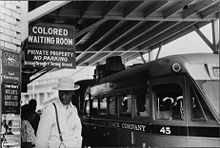 Du Bois encountered Jim Crow segregation for the first time when he attended Fisk University in Tennessee.
Du Bois encountered Jim Crow segregation for the first time when he attended Fisk University in Tennessee.
Relying on money donated by neighbors, Du Bois attended Fisk University, a historically black college in Nashville, Tennessee, from 1885 to 1888. His travel to and residency in the South was Du Bois’s first experience with Southern racism, which encompassed Jim Crow laws, bigotry, and lynchings. After receiving a bachelor’s degree from Fisk, he attended Harvard College (which did not accept course credits from Fisk) from 1888 to 1890, where he was strongly influenced by his professor William James, prominent in American philosophy. Du Bois paid his way through three years at Harvard with money from summer jobs, an inheritance, scholarships, and loans from friends. In 1890, Harvard awarded Du Bois his second bachelor’s degree, cum laude, in history. In 1891, Du Bois received a scholarship to attend the sociology graduate school at Harvard.
In 1892, Du Bois received a fellowship from the John F. Slater Fund for the Education of Freedmen to attend the University of Berlin for graduate work. While a student in Berlin, he traveled extensively throughout Europe. He came of age intellectually in the German capital, while studying with some of that nation’s most prominent social scientists, including Gustav von Schmoller, Adolph Wagner and Heinrich von Treitschke. After returning from Europe, Du Bois completed his graduate studies; in 1895 he was the first African American to earn a Ph.D. from Harvard University.
Wilberforce and University of Pennsylvania
 “Between me and the other world there is ever an unasked question: … How does it feel to be a problem? … One ever feels his two-ness,–an American, a Negro; two souls, two thoughts, two unreconciled strivings; two warring ideals in one dark body, whose dogged strength alone keeps it from being torn asunder … He would not Africanize America, for America has too much to teach the world and Africa. He would not bleach his Negro soul in a flood of white Americanism, for he knows that Negro blood has a message for the world. He simply wishes to make it possible for a man to be both a Negro and an American, without being cursed and spit upon by his fellows, without having the doors of Opportunity closed roughly in his face.”
“Between me and the other world there is ever an unasked question: … How does it feel to be a problem? … One ever feels his two-ness,–an American, a Negro; two souls, two thoughts, two unreconciled strivings; two warring ideals in one dark body, whose dogged strength alone keeps it from being torn asunder … He would not Africanize America, for America has too much to teach the world and Africa. He would not bleach his Negro soul in a flood of white Americanism, for he knows that Negro blood has a message for the world. He simply wishes to make it possible for a man to be both a Negro and an American, without being cursed and spit upon by his fellows, without having the doors of Opportunity closed roughly in his face.”
—Du Bois, “Strivings of the Negro People”, 1897
In the summer of 1894, Du Bois received several job offers, including one from the prestigious Tuskegee Institute; he accepted a teaching job at Wilberforce University in Ohio. At Wilberforce, Du Bois was strongly influenced by Alexander Crummell, who believed that ideas and morals are necessary tools to effect social change. While at Wilberforce, Du Bois married Nina Gomer, one of his students, on May 12, 1896.
After two years at Wilberforce, Du Bois accepted a one-year research job from the University of Pennsylvania as an “assistant in sociology” in the summer of 1896. He performed sociological field research in Philadelphia’s African-American neighborhoods, which formed the foundation for his landmark study, The Philadelphia Negro, published two years later while he was teaching at Atlanta University. It was the first case study of a black community.
While attending the Negro Academy in 1897, Du Bois presented a paper in which he rejected Frederick Douglass‘ plea for black Americans to integrate into white society. He wrote: “we are Negroes, members of a vast historic race that from the very dawn of creation has slept, but half awakening in the dark forests of its African fatherland.” In the August 1897 issue of Atlantic Monthly, Du Bois published “Strivings of the Negro People”, his first work aimed at the general public, in which he enlarged on his thesis that African Americans should embrace their African heritage.
Atlanta University
In July 1897, Du Bois left Philadelphia and took a professorship in history and economics at the historically black Atlanta University. His first major academic accomplishment was the 1899 publication of The Philadelphia Negro, a detailed and comprehensive sociological study of the African-American people of Philadelphia, based on the field work he did in 1896–1897. The work was a breakthrough in scholarship, because it was the first scientific sociological study in the U.S., and the first scientific study of African Americans. In the study, Du Bois coined the phrase “the submerged tenth” to describe the black underclass, anticipating the “talented tenth” term he would popularize in 1903 to describe society’s elite class. Du Bois’s terminology reflected his opinion that the elite of a nation, black and white, was the critical portion of society that was responsible for culture and progress. Du Bois’s writings of this era were often dismissive of the underclass, employing characterizations such as “lazy” or “unreliable,” but he – in contrast to other scholars – attributed many societal problems to the ravages of slavery.
Du Bois’s output at Atlanta University was prodigious, in spite of a limited budget: He produced numerous social science papers and annually hosted the Atlanta Conference of Negro Problems. Du Bois also received grants from the U.S. government to prepare reports about African-American workforce and culture. His students considered him to be a brilliant, but aloof and strict, teacher.
Booker T. Washington and the Atlanta Compromise
In the first decade of the new century, Du Bois emerged as a spokesperson for his race, second only to Booker T. Washington. Washington was the director of the Tuskegee Institute, and wielded tremendous influence within the African-American community. Washington was the architect of the Atlanta Compromise, an unwritten deal he struck in 1895 with Southern white leaders who had taken over government after the failure of Reconstruction. The agreement provided that Southern blacks would submit to discrimination, segregation, lack of voting rights, and non-unionized employment; that Southern whites would permit blacks to receive a basic education, some economic opportunities, and justice within the legal system; and that Northern whites would invest in Southern enterprises and fund black educational charities.
Many African Americans opposed Washington’s plan, including DuBois, Archibald H. Grimke, Kelly Miller, James Weldon Johnson and Paul Laurence Dunbar – representatives of the class of educated blacks that Du Bois would later call the “talented tenth.” Du Bois felt that African Americans should fight for equal rights, rather than passively submit to the segregation and discrimination of Washington’s Atlanta Compromise.
Du Bois was inspired to greater activism by the lynching of Sam Hose, which occurred near Atlanta in 1899. Hose was tortured, burned and hung by a mob of two thousand whites. When walking through Atlanta to discuss the lynching with a newspaper editor, Du Bois encountered Hose’s burned knuckles in a storefront display. The episode numbed Du Bois, and he resolved that “one could not be a calm cool, and detached scientist while Negroes were lynched, murdered, and starved.” Du Bois realized that “the cure wasn’t simply telling people the truth, it was inducing them to act on the truth.”
In 1901, Du Bois wrote a review critical of Washington’s book Up from Slavery, which he later expanded and published to a wider audience as the essay “Of Mr. Booker T. Washington and Others” in The Souls of Black Folk. One of the major contrasts between the two leaders was their approach to education: Washington felt that African-American schools should limit themselves to industrial education topics such as agricultural and mechanical skills. However, Du Bois felt that black schools should also offer a liberal arts curriculum (including the classics, arts, and humanities), because liberal arts were required to develop a leadership elite.
Niagara Movement
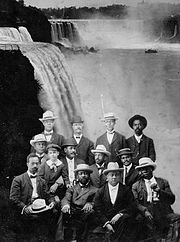 Founders of the Niagara Movement in 1905. Du Bois is in middle row, with white hat.
Founders of the Niagara Movement in 1905. Du Bois is in middle row, with white hat.
In 1905, Du Bois and several other African-American civil rights activists – including Fredrick L. McGhee, Jesse Max Barber and William Monroe Trotter – met in Canada, near Niagara Falls. There they wrote a declaration of principles opposing the Atlanta Compromise, and incorporated as the Niagara Movement in 1906. Du Bois and the other “Niagarites” wanted to publicize their ideals to other African Americans, but most black periodicals were owned by publishers sympathetic to Washington, so Du Bois bought a printing press and started publishing Moon Illustrated Weekly in December 1905. It was the first African-American illustrated weekly, and Du Bois used it to attack Washington’s positions, but the magazine only endured for about eight months. Du Bois soon founded and edited another vehicle for his polemics, The Horizon: A Journal of the Color Line, which debuted in 1907.
The Niagarites held a second conference in August 1906, in celebration of the 100th anniversary of John Brown’s birth, at the site of Brown’s raid on Harper’s Ferry. Reverdy Cassius Ransom spoke and addressed the fact that Washington’s primary goal was to provide employment to blacks: “Today, two classes of Negroes, … are standing at the parting of the ways. The one counsels patient submission to our present humiliations and degradations; … The other class believe that it should not submit to being humiliated, degraded, and remanded to an inferior place … it does not believe in bartering its manhood for the sake of gain.”
 Title page of the second edition of The Souls of Black Folk
Title page of the second edition of The Souls of Black Folk
In an effort to portray the genius and humanity of the black race, Du Bois published The Souls of Black Folk, a collection of 14 essays, in 1903. The book’s import to African Americans, according to James Weldon Johnson, was comparable to that of Uncle Tom’s Cabin. The introduction famously proclaimed that “… the problem of the Twentieth Century is the problem of the color line.” Each chapter begins with two epigraphs – one from a white poet, and one from a black spiritual – to demonstrate intellectual and cultural parity between black and white cultures. A major theme of the work was the double consciousness that African Americans faced: Being both American and black, a unique identity which, according to Lewis, had been a handicap in the past, but could be a strength in the future: “Henceforth, the destiny of the race could be conceived as leading neither to assimilation nor separatism but to proud, enduring hyphenation.”
Racial violence
Two calamities in the autumn of 1906 shocked African Americans, and helped Du Bois’s struggle for civil rights to prevail over Booker T. Washington’s accommodationism. First, President Teddy Roosevelt dishonorably discharged 167 black soldiers because they were accused of crimes as a result of the Brownsville Affair. Many of the discharged soldiers had served for 20 years and were near retirement. Second, in September, riots broke out in Atlanta, precipitated by unfounded allegations of black men assaulting white women, which compounded interracial tensions created by a job shortage and employers playing black workers against white workers. Ten thousand whites rampaged through Atlanta, beating every black person they could find, resulting in over 25 deaths. In the aftermath of the 1906 violence, Du Bois urged blacks to withdraw their support from the Republican party, because Republicans Roosevelt and William Howard Taft did not support blacks. Most African Americans had been loyal to the Republican party since the time of Abraham Lincoln.
Du Bois wrote the essay, “A Litany at Atlanta”, which asserted that the riot demonstrated that the Atlanta Compromise was a failure because, despite upholding their end of the bargain, blacks had failed to receive legal justice. The Compromise was no longer effective because, according to historian David Lewis, white patrician plantation owners that originally agreed to the compromise had been replaced by aggressive businessmen who were willing to pit blacks against whites. These two calamities were watershed events for the African-American community, and marked the downfall of Washington’s Atlanta Compromise and the ascendancy of Du Bois’ vision of equal rights.

